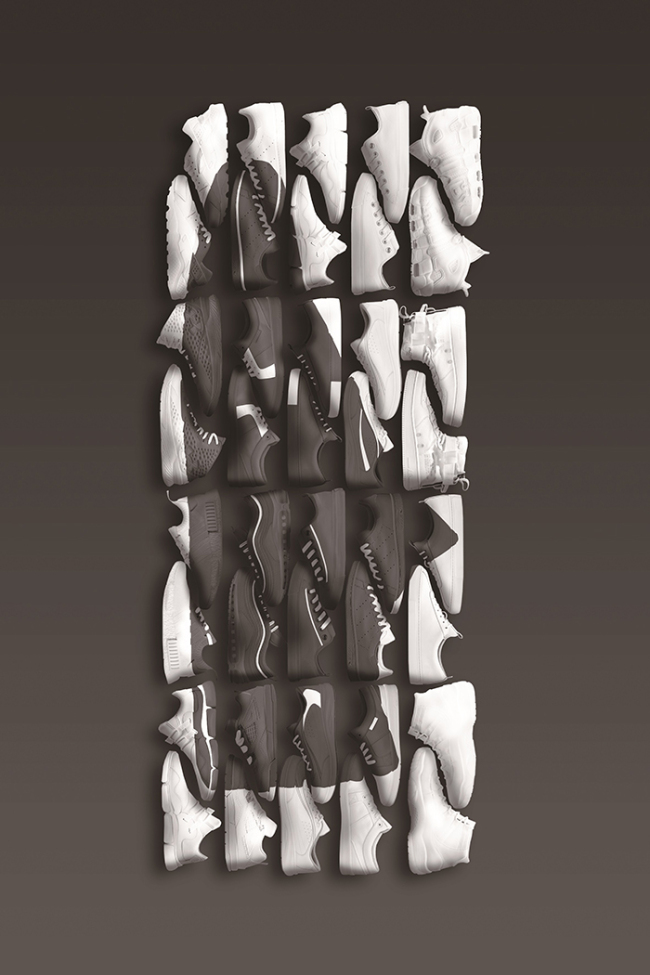[Weekender] The sneakers revolution
Rubber sole invasion signifies paradigm shifts in fashion, lifestyle and industry, experts say
By Cho Chung-unPublished : July 12, 2018 - 17:09
Carrie Bradshaw from “Sex and the City” and her collection of Manolo Blahnik stilettos were indisputably fashion icons of the 2000s.
The pointy, faintly high heels symbolized feminine glamor and were an expression of self-confidence and sexuality. But in the fashion year of 2018, something unthinkable for Carrie is happening.
Women are ditching heels and formal black shoes that have ruled the world since the Baroque period of the 17-18th centuries. Instead, they are turning to sneakers that fashion-unconscious dads in the 1980s might have worn on the weekends.
The mainstream footwear of the fashion world today has shifted to Adidas tennis sneakers matched with dresses, Nike’s vintage gym shoes -- such as Air Max 95 and 97 -- with formal business suits, and the wedding guest look with Balenciaga’s Speed Runner made of mesh and rubber, not genuine leather.
The pointy, faintly high heels symbolized feminine glamor and were an expression of self-confidence and sexuality. But in the fashion year of 2018, something unthinkable for Carrie is happening.
Women are ditching heels and formal black shoes that have ruled the world since the Baroque period of the 17-18th centuries. Instead, they are turning to sneakers that fashion-unconscious dads in the 1980s might have worn on the weekends.
The mainstream footwear of the fashion world today has shifted to Adidas tennis sneakers matched with dresses, Nike’s vintage gym shoes -- such as Air Max 95 and 97 -- with formal business suits, and the wedding guest look with Balenciaga’s Speed Runner made of mesh and rubber, not genuine leather.

According to the Korea Federation of Textile Industries, the size of the sneakers market in Korea doubled from 1.22 trillion won ($1.08 billion) in 2009 to 2.44 trillion last year, and is projected to grow to 3.5 trillion won this year. The proportion of sneakers sales out of the entire shoes category surpassed 50 percent in 2016 and reached 53 percent last year.
Even in South Korea’s highly rigid corporate world, sneakers are being accepted as daily business attire.
“It’s so comfortable, especially on rainy days. And because I feel less tired all day long, it makes my work more productive,” said Lee Yong-jae, a public relations specialist at SK Telecom, the telecom arm of the nation’s third-largest conglomerate SK Group, which has been encouraging workers to wear business casual.
Forget about the Chanel 2.55 and the Hermes Birkin.
Luxury purses are no longer must-haves in the world of high fashion here, but sneakers are. Balenciaga’s Triple S Trainers priced more than 1 million won were sold out in five minutes, according to UK online retailer MatchesFashion in an interview with Vogue Korea. South Koreans were the top buyers and also in the entire sneaker category, it added.
“I don’t see the merit of ‘collecting’ luxury purses anymore, as they seem more common. Sneakers seem to be a better way to express myself and a rarer chance to indulge in luxury,” said Lee Joo-young, a 39-year-old mother of 4-year-old twins in Seoul.
But is this sneakers phenomenon happening in association with the “well-being” trend or feminism movement? Or is this just a contemporary fashion trend that will be replaced by something that looks cooler soon?
“The sneakers boom is not just a fashion trend. It signifies paradigm transitions in lifestyle and industry,” said Kan Ho-sup, president of the Korea Fashion & Culture Association.
“The boundaries between genders, age, social classes and the differences between high-fashion and street fashion are becoming blurry,” said Kan, a fashion expert here who was a mentor on the hit TV show “Project Runway Korea.”
Rarity and perfection by luxury fashion houses no longer excites consumers any more.
Denying the traditional notion of standard beauty, fashion leaders today are seeking something “ugly” or unique and unexpectedly fun by mixing elements that are somewhat heterogeneous.
“Ugly shoes seem to have gained popularity along with the retro trend that accentuated big logos and exaggerated shoulders in the 1980s and 1990s as well as the fashion instinct of pursuing something new,” said Nam Mi-young, fashion editor at Nylon.
“Partly it is also because of the influence of fashion icons like Demna Gvasalia of Vetements and Alessandro Michele of Gucci,” she said.
From the industry’s point of view, the rise of sneakers reflects the demise of craftsmanship.
“The number of artisans for designer shoe brands has declined significantly, since there’re not many people seeking to inherit their craftsmanship in this digital era. They don’t care whether they are mass-produced Nike or hand-made Berluti as long as they look cool,” Kan said.
“Take a look at Givenchy and Valentino, people love their contemporary items with prints and industrial elements such as steel studs. This reflects that the luxury fashion houses are moving on,” he said, adding that the fashion world is experiencing “tide-like” change.
Sportswear company Nike, meanwhile, has seen growth all over the world. Its shares are up 34 percent over the past 12 months. Its revenue from the Asia-Pacific region and Latin America gained 12 percent, and 35 percent in China.
By Cho Chung-un (christory@heraldcorp.com)








![[Graphic News] More Koreans say they plan long-distance trips this year](http://res.heraldm.com/phpwas/restmb_idxmake.php?idx=644&simg=/content/image/2024/04/17/20240417050828_0.gif&u=)
![[KH Explains] Hyundai's full hybrid edge to pay off amid slow transition to pure EVs](http://res.heraldm.com/phpwas/restmb_idxmake.php?idx=644&simg=/content/image/2024/04/18/20240418050645_0.jpg&u=20240419100350)






![[From the Scene] Monks, Buddhists hail return of remains of Buddhas](http://res.heraldm.com/phpwas/restmb_idxmake.php?idx=652&simg=/content/image/2024/04/19/20240419050617_0.jpg&u=20240419175937)

![[KH Explains] Hyundai's full hybrid edge to pay off amid slow transition to pure EVs](http://res.heraldm.com/phpwas/restmb_idxmake.php?idx=652&simg=/content/image/2024/04/18/20240418050645_0.jpg&u=20240419100350)

![[Today’s K-pop] Illit drops debut single remix](http://res.heraldm.com/phpwas/restmb_idxmake.php?idx=642&simg=/content/image/2024/04/19/20240419050612_0.jpg&u=)